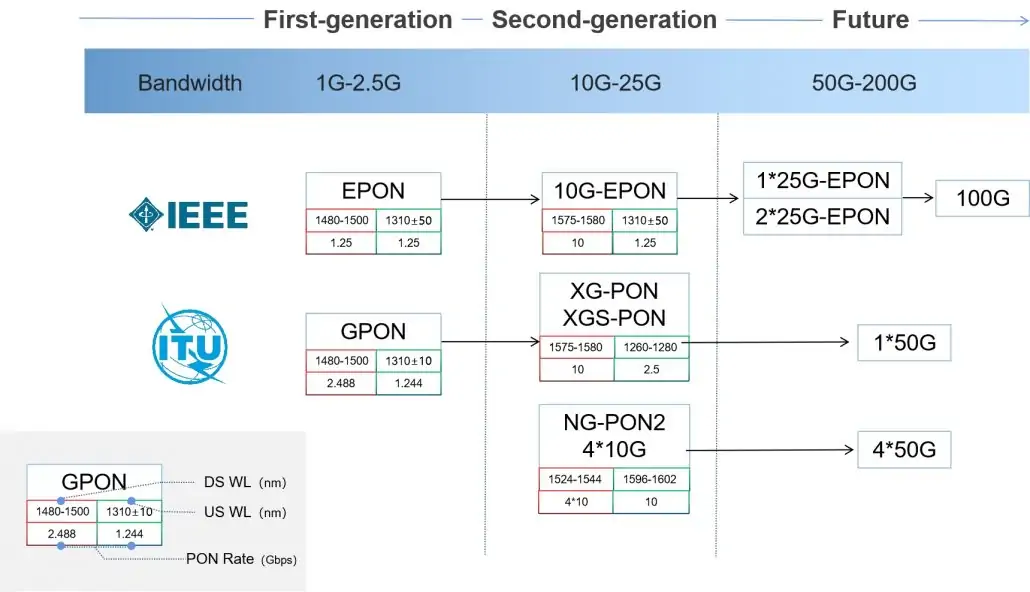Understanding GPON and XGPON: Fiber Access Network Evolution
telcomatraining.com – In today’s digital era, high-speed internet access is no longer a luxury but a necessity. Whether for residential, business, or industrial use, fiber-optic networks have become the backbone of global communication infrastructure. Among the various fiber technologies, GPON (Gigabit Passive Optical Network) and XGPON (10-Gigabit-capable Passive Optical Network) play a crucial role in shaping modern broadband access. This article explores the evolution from GPON to XGPON, highlighting their technical differences, benefits, and how they meet the growing demands for high-speed connectivity.
What is GPON?
GPON stands for Gigabit Passive Optical Network. It is a standard developed by the ITU-T (International Telecommunication Union – Telecommunication Standardization Sector) under the G.984 series. GPON uses passive splitters in the optical distribution network, allowing a single fiber line to serve multiple endpoints, typically up to 64 users per port. This architecture reduces infrastructure costs while providing high-speed connectivity.
GPON supports downstream speeds of up to 2.5 Gbps and upstream speeds of up to 1.25 Gbps. While these speeds were revolutionary at the time of GPON’s inception, the increasing demand for bandwidth-heavy applications like 4K streaming, online gaming, cloud computing, and remote work has pushed the limits of GPON.
Introduction to XGPON
As digital needs outpaced GPON’s capabilities, the industry developed XGPON—also known as 10G-PON or XG-PON1—as part of the ITU-T G.987 standard. XGPON represents a significant upgrade over GPON by offering up to 10 Gbps downstream and 2.5 Gbps upstream speeds. This makes XGPON better suited for applications that require symmetrical high-bandwidth performance, such as enterprise services, smart cities, and large-scale cloud services.
Importantly, XGPON is designed to coexist with GPON on the same fiber infrastructure. This allows service providers to upgrade their network gradually without the need for a complete system overhaul.
Key Differences Between GPON and XGPON
| Feature | GPON | XGPON (XG-PON1) |
|---|---|---|
| Downstream Speed | 2.5 Gbps | 10 Gbps |
| Upstream Speed | 1.25 Gbps | 2.5 Gbps |
| Standard | ITU-T G.984 | ITU-T G.987 |
| Coexistence | N/A | Compatible with GPON |
| Use Case | Residential and small biz | Enterprise and high demand |
While GPON is still widely used due to its cost-effectiveness and reliability, XGPON provides a future-proof solution for network expansion and next-generation services.
Why the Transition Matters
The transition from GPON to XGPON is driven by the exponential increase in internet usage and connected devices. With the rise of IoT, cloud services, and remote work, networks need to support much higher throughput and lower latency. XGPON helps bridge the gap between current network capabilities and future requirements.
For telecom operators, upgrading to XGPON offers competitive advantages such as increased customer satisfaction, improved service quality, and the ability to introduce premium broadband packages. End-users benefit from faster downloads, smoother video conferencing, and better overall internet experiences.
Future Evolution: Beyond XGPON
While XGPON addresses today’s needs, further advancements like XGS-PON (symmetric 10 Gbps) and NG-PON2 (Next-Generation PON 2) are already shaping the future of fiber broadband. These technologies offer even greater speeds, lower latency, and enhanced scalability, paving the way for 5G backhaul, industrial automation, and smart city infrastructure.
Conclusion
Understanding the evolution from GPON to XGPON is essential for telecom providers, network engineers, and end-users alike. While GPON remains a reliable and cost-efficient solution for many, XGPON represents a critical step toward meeting the increasing demand for ultra-fast, high-capacity internet. By investing in scalable and future-ready technologies, we can ensure that our fiber access networks continue to evolve with the digital age.







